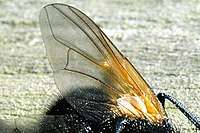Mesembrina meridiana
Mesembrina meridiana, sometimes known as the noon fly or noonday fly, is a species of fly in the family Muscidae.[1]
| Mesembrina meridiana | |
|---|---|
 | |
| Mesembrina meridiana ♂ Male | |
| Scientific classification | |
| Kingdom: | |
| Phylum: | |
| Class: | |
| Order: | |
| Family: | |
| Genus: | |
| Species: | M. meridiana |
| Binomial name | |
| Mesembrina meridiana | |
| Synonyms | |
Distribution
This common species is widespread in most of Europe, in the Near East, in the East Palearctic ecozone (Russia, Mongolia, China) and in North Africa.[2][3]
Description
Mesembrina meridiana can reach a length of 9–13 millimetres (0.35–0.51 in).[4] These medium large flies have a stout body. Thorax and abdomen are shiny black, covered with uniform black hair. Numerous bristles are present on the edge of the scutellum. Occiput has no yellow hairiness. Eyes are bare and the cheeks under the eyes are covered with fine yellow short hairs. Orbits are separated by a wide black space. Antennae and palps are black, but arista is yellow. An orange colouration is present on the base of the wings, on the feet and the face.[4]
This species can be easily confused with Mesembrina resplendens and Mesembrina intermedia.
Biology
This species is ovoviviparous, as the eggs hatch prior or within an hour after deposition.[5] The female lays up to five eggs in a lifetime, each one in a different pat, at two-day intervals. Eggs are laid in cow dung.
Adults can be found between late April and late October, particularly in cattle-rearing areas, on cow dung or basking in open ground. They mate in cow or horse dung. They feed on nectar and pollen of flowers of plants, especially Apiaceae (Heracleum and Pastinaca species),[5] or on overripe berries.[4] The larvae are carnivorous, and feed on other fly larvae within the dung.[4][6]
Gallery
 Mating
Mating_female_(14357856892).jpg) ♀ Female
♀ Female Detail of a wing
Detail of a wing
Bibliography
- Colyer, C.N., & Hammond, C.O. (1968). Flies of the British Isles, ed. 2, Frederick Warne & Co., London
- Michael Chinery, Insectes de France et d'Europe occidentale, Paris, Flammarion, août 2012, 320 p. (ISBN 978-2-0812-8823-2), p. 214-215
References
| Wikispecies has information related to Mesembrina meridiana |
| Wikimedia Commons has media related to Mesembrina meridiana. |
- BioLib
- Catalogue of life
- Fauna europaea
- Entomoland-Entomologie and Macrophotographie
- Peter Skidmore The Biology of the Muscidae of the World
- Skidmore, P.: Insects of the British Cow Dung Community